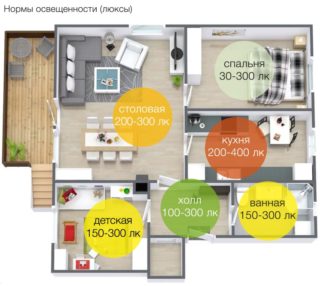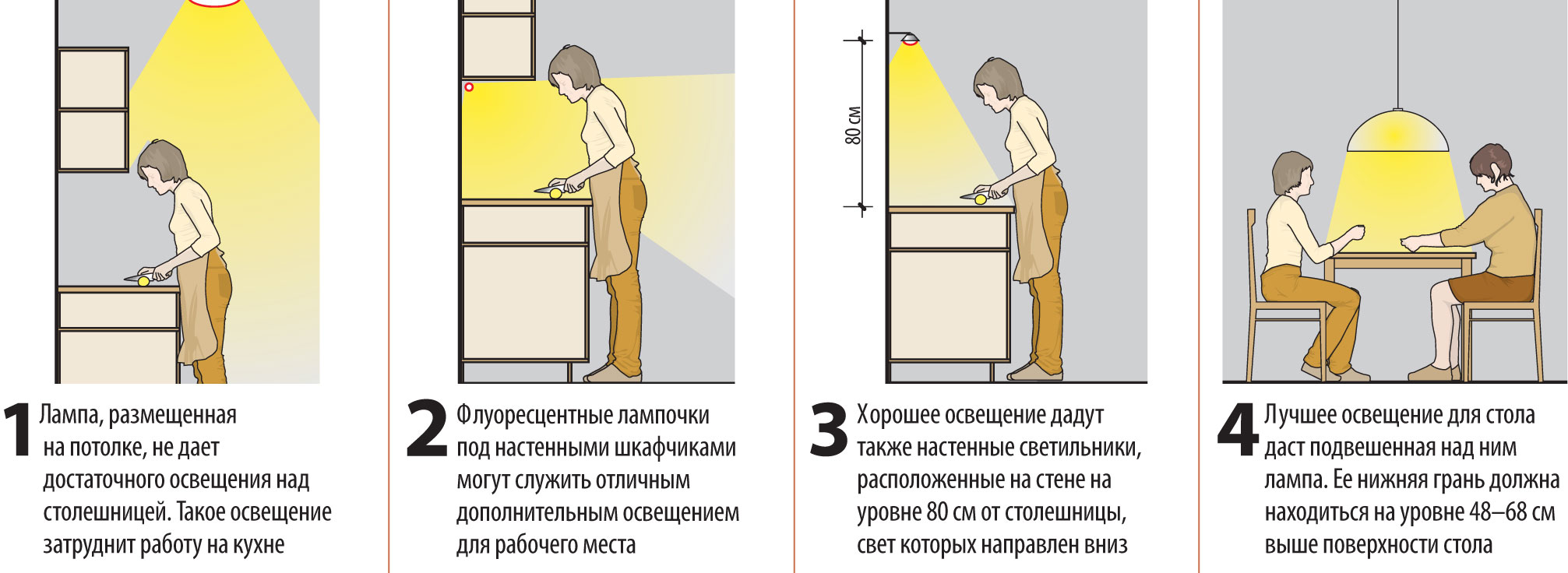The kitchen is a place where the whole family gathers at a common table, and the hostess also spends a lot of time in the process of cooking and cleaning the room. For a more comfortable stay in it, the lighting should be of high quality. Lighting for the kitchen requires a lot of attention: choosing the right type of bulbs and lighting fixtures, their number and place of installation, as well as many other points. When designing, it is important to familiarize yourself with the requirements of SNiP.
Principles and requirements
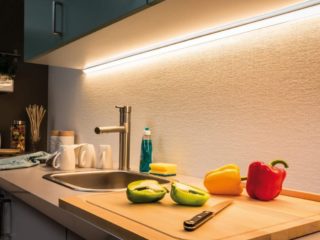
The entire kitchen space is usually divided into two main areas - dining and working. The requirements for their lighting have many differences and features. For the dining area, it is more advisable to install comfortable and soft lighting. For the sake of safety and comfort, the work area must be well lit so that all processes are visible.
Basic requirements for kitchen lighting:
- The light is made bright, but everything should be measured. The glow should not irritate the eyes and dazzle. The backlight can be slightly more intense than the main light source.
- If a single source of light is provided - a chandelier, then even in a small room sufficient volume will not be provided. They mount it, as a rule, in the center of the room, therefore, the hostess will turn off the light while cooking.
- During the design phase, it is important to place the luminaires in such a way that they do not create shadows from objects.
- The bulbs built into the cooker hood only illuminate the stove, this is not enough for comfortable and safe work.
- When choosing lighting fixtures for your work area, it is important that they match with other interior elements in the room.
- The calculation of the required number of luminaires must be carried out in advance.
- It is recommended to give preference to energy saving lamps.
- Choosing the brightness and shade of the glow of the lamps, it is also necessary to analyze the color of the kitchen set and walls.
The working area includes a sink, so it is important to take into account that the optimal distance between the light source and the water should be at least 50 cm.
Lighting rules
- diode lamps - for 1 square meter 4 W;
- halogen lamps - 1 square meter 30 W;
- incandescent lamps - 1 square meter 9 W;
- fluorescent lamps - 1 square meter 26 W.
It is also important to take into account some features of the light.
- Daylight, aka white light, distorts the color of prepared food and food.
- For headsets made of wood, it is preferable to use warm light, and for modern design solutions, daylight is preferable.
- Colored lighting installed for the working area is used only for decorative purposes, it is very inconvenient to work with it.
It is important to take care of the ability to adjust the light intensity.
At the design stage of lighting lighting in the kitchen, you need to decide how many lighting fixtures you need to install, as well as determine their power. The task may seem daunting at first, but it is worth turning to the norms. The optimal amount of illumination for the kitchen is not less than 150 lux per 1 sq.
It is impractical to count in watts, since in most modern light bulbs, the light output per unit of power is not at all the same as that of incandescent lamps.
For calculations, it is enough to multiply the area of the room by the norm. However, experts advise to additionally multiply the resulting number by a factor of 1.5.
When zoning a room, most of the lighting fixtures should be installed in the working area.
Methods and places for interior lighting in the kitchen
When organizing lighting in the kitchen, you need to take care not only of zoning, but also traditional general lighting. It can be implemented in several ways.
- The classic way that was common in Soviet times. The bottom line is to hang a chandelier from the center of the ceiling. The method is practical, but it has a significant drawback - the uneven distribution of lighting throughout the room.
- Spot lighting is a fairly modern method that quickly gained popularity. In stores you can find a large assortment of spotlights. The choice depends, first of all, on the material from which the ceiling is made: drywall, canvas, wood, concrete.
- Combi lighting combines the installation of a chandelier and spotlights in a wide variety of configurations.
When it comes to standard ceilings, it is recommended to give preference to conventional surface mounted luminaires.
Illumination of the working area
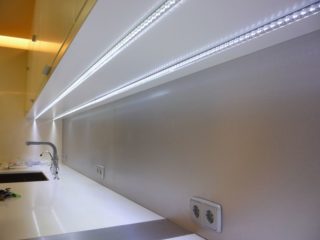
Illumination of the working area is the most crucial moment, since insufficient illumination negatively affects the eyesight of the hostess, and also increases the likelihood of injury.
When choosing lighting fixtures, the most important criteria are the type and shape of the lamps used. Better to give preference to LED. Today, this type of lighting is considered the most reliable and durable.
LED bulbs can be in the form of tubes. They are mounted on special clips - plates that are attached directly to the furniture. Luminous tubes are inserted into them. Some can be mounted on magnets. Plates made of metal are attached with double-sided tape to furniture, and lighting fixtures are simply attracted to them.
When designing, it is necessary to form such a distribution of the luminous flux so that the illumination of the countertop in the kitchen is uniform. Often they organize lighting with point lighting devices. This method has one advantage in comparison with LED strips - replacement of lamps with new ones and maintainability.
| Number of lighting fixtures for each running meter | |||||||
Lighting device type | Power | Light flow | Mounting height | ||||
| 0,4 | 0,45 | 0,5 | 0,55 | 0,6 | |||
Spotlight | 5 watts | 350 lm | 2 | 2 | 2 | 2 | 2 |
| 6 watts | 400 lm | 2 | 2 | 2 | 2 | 2 | |
| 10 watts | 750 lm | 1 | 1 | 1 | 1 | 1 | |
Backlight apron
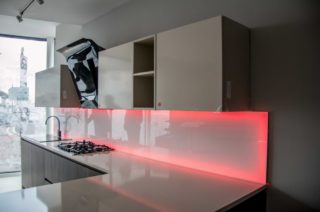
Aprons are usually backlit with LED strip. In this case, such lighting devices play not only a decorative function, but also add streams of light to the work surface. There are several important points to note:
- Installation is carried out in a special skirting board. It is preferable to make the luminous flux directed along the working surface.
- It is recommended to use a matt screen in the skirting board, otherwise glare, unpleasant to the eye, may appear.
- The tape must be moisture resistant, the protection class is at least IP65.
Illumination of cabinets inside
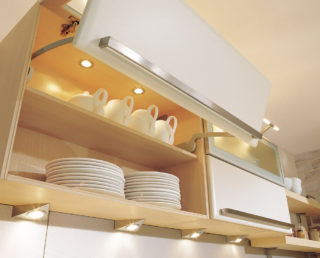
Kitchen lighting can be not only external, but also internal. The lighting inside the cabinets is convenient when you need to find something in them without turning on the main light.It can also play a decorative role.
For the installation of lamps inside, special waterproof lamps are used, the degree of protection is at least IP65. The priority also remains LED backlighting, since analogs get very hot, which can cause the headset to ignite spontaneously or damage the surface.
Illuminated dining area
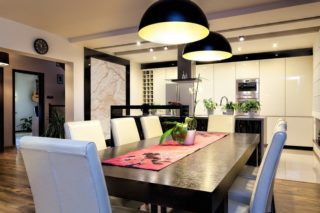
Dining area lighting is divided into two main types: wall and ceiling. It is also implemented in several methods:
- track lighting devices;
- gimbal lamps that are able to change the angle of incidence of light;
- chandelier with lampshade and variable suspension height.
The listed methods refer to general ceiling lighting, but if you wish, you can use wall lamps to accentuate the dining table. This can be done with a sconce, but only on condition that the dining table is near the wall.
LED strip for kitchen
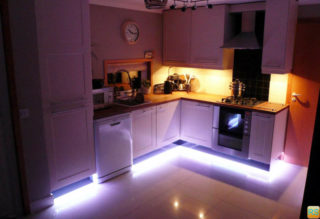
Led strips are a relatively new lighting fixture, so many potential lighting buyers are skeptical about them. However, LED kitchen lighting has many advantageous features.
- The most significant advantage is economical energy consumption, thanks to which it will be possible to significantly reduce utility bills.
- Lighting sources are compact in size, practically do not take up space, but they are capable of illuminating rather large areas.
- They are characterized by low heat transfer, which ensures a high degree of safety during operation.
- A wide variety of colors allows you to choose the most suitable option in a particular case.
If we compare ice lamps with fluorescent lamps, despite the fact that they are characterized by equally good qualities, the former are more functional and have a longer service life.
The main disadvantage of LED lighting is its high cost.
The LED strip can be attached to all surfaces immediately because the back has a sticky layer. However, it is noted that it is not always reliable enough, therefore, it is additionally fixed with a stapler or double tape. If the tape is to be installed on a kitchen set, then the first must be equipped with a protection class of at least IP-44. But it is better to give preference to models sealed in a tube.
When choosing an LED strip, it is recommended to pay attention to the size of the crystals and their brightness. The optimal size is 50 * 50 or 50 * 75, it is recommended to place them in two rows.
For safety reasons, lighting devices can be mounted in special profiles. They are usually made of aluminum.
How to choose a power supply
You can calculate the required power of the power supply for a tape 5 meters long with a power of 12 W as follows: 12 W * 5 m = 60 W. For the stock, a coefficient is added: 1.25 * 60 = 75, hence the optimal power of the power supply is 75 watts.
What is required for installation
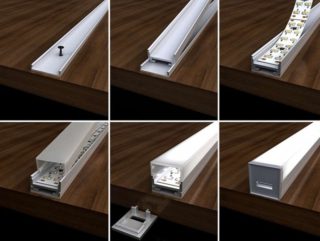
To install LED strip lighting in the kitchen, you will need the following working inventory:
- LED modules or tape;
- electrical tape, which is required to isolate the joints;
- adapter - power supply for the lighting device;
- sharp scissors for cutting LED strips;
- connecting cord with a cross-sectional area of approximately 0.6 mm2;
- double-sided tape for good fixation of parts;
- to connect to the socket wire with a plug.
You can do the work yourself, it is enough to purchase all the necessary equipment at an acceptable cost.
Tips from experts
It is simply impossible to independently figure out all the nuances of organizing lighting in the kitchen. Expert advice:
- If the working area is located near a window, you should make sure that the lighting comes at an angle, otherwise glare and shadows from objects will inevitably form. The direction of the light radiation is towards the table top.
- The lighting design should be in harmony with the design of the room. Therefore, it is recommended to immediately select devices for decorative, main and working lighting.
- It is recommended to keep the minimum distance between the worktop and the wall cabinets. It is most advisable to use swivel lamps that can be fixed to the ceiling.
- Lighting devices with shades and a large number of various decorative elements are not suitable for illuminating the workspace. Experience shows that they only accumulate grease and dirt, and putting them in order is difficult.
Neglecting high-quality lighting in the kitchen is a big mistake. Cooking in the dark can negatively affect your emotional state and increase the likelihood of injury.

